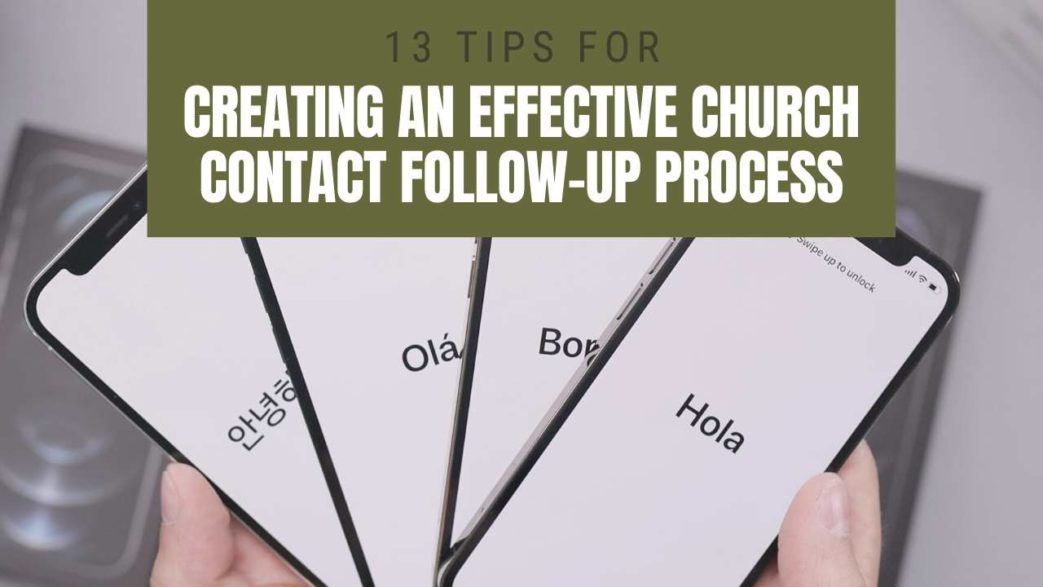Every church needs a church contact follow-up process that helps drive growth and trust.
Often, simply reaching out is all it takes to convince someone that your church is the right one for them. However, it’s easy for messages and visitors to fall through the cracks.
Whether it’s following up on emails inquiring about your church, social media messages or new visitors in your church, follow up. See what you can do to make them feel better about coming back, whether in your church or online.

1. Assign Someone To Head The Process
One of the most important steps for creating a more effective church contact follow-up process is having someone in charge. This person then creates a team to handle different types of contacts.
For instance, if you have new visitors, the team may welcome the new visitors, provide contact detail cards, answer questions and ask for contact details for following up later.
If an inquiry or comment comes in on your church website about your online sermons, you may have a few team members who not only answer the question, but follow up later.
Many churches have new contacts coming in from different areas. This means having someone to head the entire process and assign volunteers to different types of contacts. Just make sure to fully support your volunteers so they stick around.
Ideally, you’ll want a staff member to be in charge. However, if you have a highly experienced volunteer, they may also work well. Train them on what you expect and have a staff member work alongside them initially to help the process flow smoother.
2. Focus On All Contact Points
Your church isn’t limited to just new visitors when it comes to contacts. Part of a great church contact follow-up process means covering all contact points.
For instance, social media is changing the way you do church. In fact, social media may be the first impression someone has of your church. This means taking the time to follow up with followers when they comment or send you a direct or private message is important.
For many churches, you’ll have the following contact points:
- New visitors in your church
- New visitors online (can reach out in a variety of ways)
- Emails from potential visitors
- Questions or comments from your church website contact form
- Comments and questions on your church’s blog posts
- Comments and messages on social media
- Newsletter signups
- Donations (usually online tithing)
All of these are ways people interested in your church can reach out to you. Make sure to have a follow-up process that covers all your contact points so no one gets left out.
3. Set Up A Welcome Area On Your Website
You’ll need an easy way to provide answers to some of the most frequently asked questions. One of the best ways to do this is to set up a welcome area on your website.
In fact, a dedicated welcome area helps you keep new attendees coming back. But, it’s not just for those who physically attend. Maybe someone signed up for your church newsletter, but isn’t a member. Follow-up with new newsletter signups and include a link to the welcome area.
If you have contact details for anyone who has contacted you via email, your website’s contact form or social media, reach out to them after a set period has passed and introduce them to your site’s welcome area.
This is the perfect place to provide details about services, volunteer projects, videos of your church, links to online services and much more. Think of it as the ultimate welcome packet, but digital.

4. Choose How To Gather Contact Details
Obviously, you can’t have a church contact follow-up process without contact details. This is how so many new visitors slip away. You simply don’t know how to reach out to them once they leave your church.
While you won’t ever get the contact details of everyone who visits your church or engages with you online, there are ways to encourage people to provide contact details, such as:
- Offer something for free – People love free stuff and they’re more likely to sign up for a newsletter or provide details before leaving church if they get something special in return. The free item can be a simple ebook, a prayer guide or church swag, such as a basic tote bag, pencils or cup with your church’s name and logo on it.
- Ask nicely – If you’re trying to gather contact details for new visitors in your church, have your welcome team ask nicely. They’ll need to explain why, so have the reason worked out in advance. You can also do this online, such as asking any livestreaming viewers to please provide their email address to get your church newsletter or just to become an online member.
- Have a clear call to action – You’ll need a CTA both inside your church and online. Your CTA in church could just be someone pointing out how to sign up or a large sign as people walk out encouraging people to provide their details. Your online CTAs should be part of a pinned post on social media (or your bio), part of your church website and at the end of each online video you create.
Most importantly, make the sign up process simple. Only ask for what you absolutely need. Ask for a name (it can just be a first name), email address and phone number. You only need an email address or phone number, so let people know they can provide both or just one. Also, ask if contacts would rather be texted or called when providing a phone number. Millennials usually prefer texting.
The less information you ask for, the more likely people are to provide their contact details. Then, once you have the details, it’s much easier to follow up.
5. Decide How Soon To Follow Up
Ideally, you should follow-up with contacts within 48 hours. One study showed that 85% new visitors who were followed up with in 36 hours returned.
Naturally, that was just for new visitors within your church. However, the same idea applies no matter where the contact details came from. For instance, if someone signs up for your church newsletter, they should receive it immediately.
For new subscribers, reach out within a day or two to see how they liked it or if they have any questions. State that you’ll be following up X number of times just to help welcome them into your church family.
The longer you wait, the less welcome new contacts feel. This includes both online and offline. Having a team of volunteers dedicated to just this helps ensure you’re able have a much more effective church contact follow-up process.
6. Set A Follow Up Frequency
This is one of the trickiest parts. After all, you don’t want to pester someone or the follow up could have the opposite effect of what you’re trying to accomplish.
Instead, set a frequency for the initial process. You can set a limit to how long you continue to follow up. For instance, if you haven’t had a response in a month, you might decide to stop completely or pull back and only reach out every few months.
At first, your frequency should be closer together. For example, your first follow up should be within the first few days. You might wait 3-5 days for the next and a week for the third. Then, the frequency should lessen to avoid coming on too strong. Always provide a way for contacts to opt-out though.

7. Create A Customizable Response Template
One reason why churches don’t always have the best church contact follow-up process is no one really wants to write that many emails or texts. However, you still want everything to seem more personal.
Sit down with your team and create response or follow up templates. Create one for each contact point and each level of follow up. For instance, your first follow up and fourth follow up message should be different.
Once these are created, all your team has to do is add a name and maybe a date to personalize the message. This works for emails, texts, social media posts and more.
8. Make The Follow Up Useful
While you should definitely use your follow up messages to invite contacts to visit your church again (including online), do more than just provide an invitation. Offer some useful to the contact to make them engage with your message.
You could provide a link to your church website’s welcome page or a free ebook. Provide details on any interactive service elements you have that would encourage people to come back to your church both online and off.
The idea is to go beyond just a “hello” and “please come again” type message. Even if it’s just a list of your most useful blog posts, you’re giving the contact something in return for their time.
9. Focus On The Contact Instead Of The Church
It’s a great idea to introduce your church, especially if the contact comes from an online source versus an in-person visit. However, don’t focus solely on trying to sell your church to the contact. They’re already interested or they wouldn’t have provided their contact details.
Instead, focus on aspects of your church that would help the contact most. For instance, talk about social media groups where contacts can get to know other church followers and members online. Provide resources to help them if they’re struggling through something.
Think about how your church can help the contact versus just trying to gain a new member. Taking this more personalized approach feels far more welcoming and less pressuring.
10. Provide A List Of Resources
A great way to welcome a new contact during your first follow up is to provide a list of your best in-church and online resources. This gives contacts a great overview of what your church has to offer and how well your church meshes with what they need.
Some resources you might list include:
- Online church groups and social media pages
- Your church blog
- Your church website welcome page (great way to condense all your resources on a single page)
- Devotionals
- Prayers (you can even have an online prayer system)
- Volunteer guide and opportunities
- Church groups (offline) and community projects
- Giving resources

11. Create A Tracking System
Even the most well intentioned church contact follow-up process can be derailed if you don’t have a good tracking system. Without a way to track your contacts and when you last contacted them, it’s hard to build a relationship with them.
A contact management software works well to help you manage who you need to contact and when. You can even generate lists and automatic emails with some tools. Some church management software can even be configured to help with this. Tithe.ly is a great option that also helps with online tithing.
Even if it takes some training initially, the right tool makes your follow-up process much easier.
12. Choose When To Stop
As hard as it is to admit a contact isn’t interested, there comes a point when it’s obvious they’re not coming back. Set a time frame for when you’ll mark the contact as inactive. You can keep their details, but you won’t send them anything else unless they suddenly return, which can happen.
If the contact signed up for your church newsletter, keep sending it unless they unsubscribe. You can still send out special messages, such as invitations to services and events.
The time frame will vary, but usually, if you haven’t heard anything in months, it’s time to move on. You may choose to follow up once more in a year just to check in.
13. Offer Alternative Ways To Stay In Contact
Not everyone wants to stay in contact via email or text. Consider offering alternative methods. For instance, if someone provides their email address, let them know they can stay in contact with your church on Facebook instead. Or, if they’d rather receive texts, they can do that too. Or vice versa if they signed up with text and would rather receive emails.
Staying in contact with new visitors, both online and off, helps your church grow. Make sure you have a great church website to refer them to in your follow-up process. Try out our free church website evaluation today.




